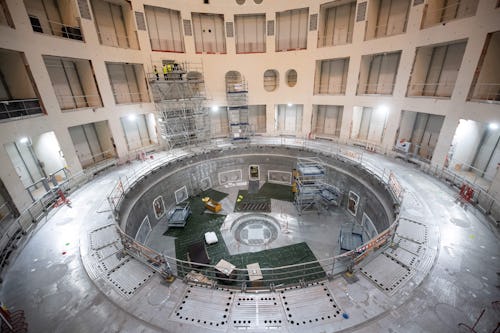
What if there was a way to produce nearly limitless, completely clean energy? And, to make this premise even better, what if it wasn’t the plot of a sci-fi horror flick where our good intentions go horribly wrong and we all end up getting eviscerated? Okay, well, there’s no guarantee that isn’t what is happening — but let’s assume that we aren’t setting ourselves down the path of nuclear destruction because as of Wednesday, we are one step closer to achieving fusion energy.
According to a report from CNN, scientists in the United Kingdom announced that they were able to successfully generate and sustain nuclear fusion for more than double the previous record. That’s a pretty big deal!
Here’s what happened, in some unfortunately jargony terms that we’re just going to have to work through together: In a giant machine called a tokamak (CNN helpfully describes it as being donut-shaped), scientists generated 59 megajoules of sustained fusion energy. How much energy is that, exactly? Well, it’s equivalent to about 16.4 kilowatt hours — which is kind of like answering a question with another question. “Okay, so how much energy is 16.4 kilowatt hours, then?” It’s about how much energy you’d need to power one home for half a day.
That’s not exactly going to blow anyone away, but it’s an important benchmark. It’s the most energy ever produced through sustained fusion, and it was generated in just five seconds. The experiment, which took place at the fusion reactor in Culham, England, on Dec. 21, pushed the machine to its limit. Any longer than five seconds and it can overheat, which would be a disaster.
That heating process is key to the whole thing, and nuclear fusion requires an incredible amount of it. Within the reactor, scientists produce plasma at a temperature of at least 100 million degrees Celsius (180 million degrees Fahrenheit) — a level that is seven times hotter than the center of the sun. That’s the fusion threshold. Once that temperature is achieved, two atoms can be fused together to create a heavier atom. That process releases a massive amount of energy, released as heat, that can be harnessed and used to produce electricity.
The achievement made by scientists in Culham is a significant step toward making nuclear fusion a reality. Developing that technology might just be the hail mary that we collectively require in order to stave off climate change. Unlike nuclear fission, which requires splitting atoms and produces radioactive waste, nuclear fusion is safer (a meltdown or dangerous reaction is not really feasible through fusion the way it is through fission) and doesn’t produce much waste.
Breakthroughs in nuclear fusion have been happening steadily over the last few years, and it’s possible that we’ll see a reactor producing a steady flow of sustained clean energy by as early as 2030. That’s good news, because we’re running out of time to cut down on our fossil fuel habit and keep temperatures from warming to unsustainable levels. Ironic that extreme heat in a nuclear reactor might be the thing that saves us from extreme heat across the planet.







